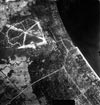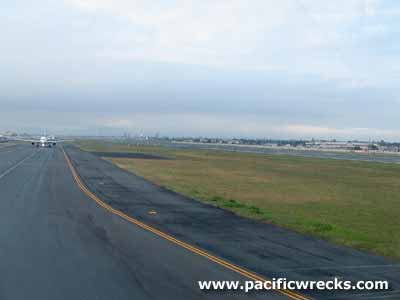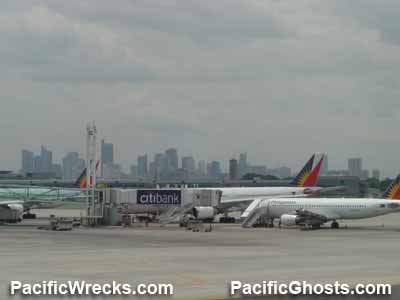|
|
|
|
| Missing In Action (MIA) | Prisoners Of War (POW) | Unexploded Ordnance (UXO) |
| Chronology | Locations | Aircraft | Ships | Submit Info | How You Can Help | Donate |
|
 US Army c1930s  Edsall Spring 1941  3rd Pursuit Sqad 1941     USAAF c1945  Justin Taylan 2004  Justin Taylan 2005 |
Location Nichols Field was located in southern Manila on Luzon in the Philippines. Borders Manila Bay to the west. During the 1920s known as Camp Nichols. Today known as Ninoy Aquino Airport (NAA) or Manila Airport in the National Capital Region (NCR). Construction Built by the U.S. Army with two parallel runways run oriented roughly northwest to southeast with taxiways, hangars and buildings. Used by the Far East Air Force (FEAF) pursuit aircraft (fighters) including P-26s, P-35s and later P-40 Warhawk fighter aircraft. Wartime History On December 8, 1941 P-40 Warhawks took off from Nichols Field to intercept enemy aircraft spotted on radar at Iba, but failed to make contact. In the afternoon, P-40s again took off from Nichols Field to patrol over Bataan and Manila. On December 9, 1941 shortly after 3:00am Japanese aircraft strike Nichols Field. Far East Air Force (FEAF) units based at Nichols Field (Defense of Philippines) 24th PG, 3rd BS (P-40E) Iba December 9, 1941–December 25, 1941 Bataan 24th PG, 17th PS (P-26, P-35A, P-40E late Nov 1941) from USA late October 1940–Dec 9, 1941 to Clark 24th PG, 20th PS (P-35, P-40) Hamilton October 1940 - December 9, 1941 to Clark 24th PG, 21st PS (P-40E) ? - December 12, 1941 to Del Carmon Philippine Army Air Corps (PAAC) units at Nichols Field (Defense of Philippines) 4th CG, 6th PS (P-26) December 11, 1941 departs Batangas Japanese Occupation After Manila was declared an "Open City" the Japanese occupied Nichols Field and used it as a military airfield during the occupation of the Philippines. On May 19, 1942 the Japanese had American prisoner of war (POW) pilots Crosland and Erickson fly two P-40 Warhawks and a Stearman biplane from Davao Airfield to Nichols Field. One of the P-40s was delayed due to landed at a small airstrip en route due to bad weather. This was the last flight of the FEAF during the defense of the Philippines. Japanese units based at Nichols 1021 Kokutai (G4M) stationed at Nichols and Cebu As the threat of American liberation approached, the Japanese anticipated an attack on Manila to come from south and defenses added to the airfield including anti-aircraft guns, pillboxes, gun positions and bunkers, manned by troops from the Japanese Navy, 3rd Naval Battalion. American missions against Nichols Field April 12, 1942 - February 13, 1945 On February 6, 1945 the 511th Para Inf of 11th Airborne Division moves forward in preparation for attack on Nichols Field. On February 9, 1945 the 11th Airborne Division meet intense opposition at Nichols Field. American Use During February 1945, Nichols Field was liberated by U.S. Army troops. At the airfield, many wrecked Japanese Navy and Army aircraft were captured including several largely intact. J2M3 Jack Manufacture Number 3013 Captured largely intact on February 20, 1945 After being repaired, Nichols Field was designated as US Army APO 75. For the remainder of the Pacific War, used by several U.S. Army Air Force (USAAF) squadrons, Air Transport Command (ATC) and Naval Air Transport Service (NATS). Between 1945-1946 a NATS detachment of six officers operated DC-3 transports was based at Nichols Field. American units based at Nichols (liberation) 5th BG, 31st BS (B-24) Guiuan Airfield circa 1945 403rd TCG, 13th TCS (C-54) June 15, 1946–October 15, 1946 inactivated Postwar Nichols Field remained active as a military airfield known as Nichols Air Base. and airport. After Philippine independence, renamed Vilamor Philippine Military Air Base. Today On August 21, 1983, when politician Benigno "Ninoy" Aquino, Jr. returned to the Philippines from his self-imposed exile in the United States was assassinated at the airport. In 1988, the airport was renamed by Republic Act No. 6639 as Ninoy Aquino International Airport (NAIA) in his honor. Unofficially, the airport is still known as Manila International Airport or Manila Airport. Ninoy Aquino International Airport or Ninoy Aquino Airport is the primary airport serving the Manila area and used as a civilian port of entry and military airport with two runways. The first oriented 24/06 measures 12,261' x 197' surfaced with concrete. The second oriented 31/13 measures 7,408' x 148' surfaced with concrete. Airport codes: ICAO: RPLL IATA: MNL. The airport is also shared by the Philippine Air Force (PAF) for use by military aircraft. Adjacent is the Vilamor Philippine Military Air Base with the Philippine Air Force Museum (PAF Museum). References Manila International Airport Authority official webpage PAF Colonel Jesus Villamor Air Base - official webpage via Wayback Machine November 30, 2017 Doomed At The Start (1995) pages 424-426 Contribute
Information Last Updated
|
Map 1945 Map Fallingrain Photo Archive View on Google Earth |
| Discussion Forum | Daily Updates | Reviews | Museums | Interviews & Oral Histories |
|